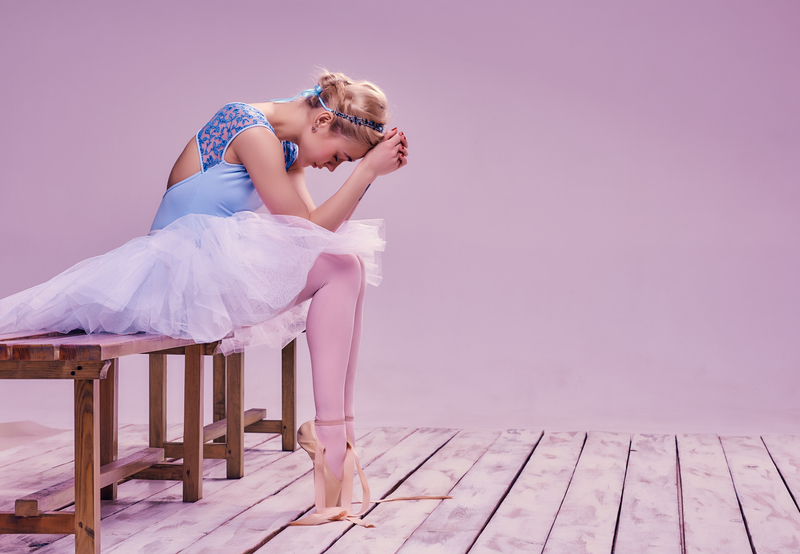Have you ever been in a dance studio setting and seen a student taking class with an injury? Have you heard a teen dancer say something like, “Yeah, I really did a number on my ankle yesterday, but I have to make this rehearsal, so I’m just going to push through”? Perhaps you’ve even heard a director, teacher or choreographer praise a young dancer for “being tough” and for “not letting their teammates down” when they were genuinely sick or injured.
The specialists at Youth Protection Advocates in Dance (YPAD) are concerned for the young dancers of today who are not being taught to take self-care seriously. With chronic and acute injuries on the rise among youth in dance due to forced flexibility, unhealthy exertion levels and other factors, the way we handle injuries and sickness has perhaps never been more important.
Past just the physical ramifications, YPAD urges the dance industry to consider the psychological message we send our youth when we brush off injuries and neglect signs of pain or illness.
Glorifying toughness
Resilience is a great trait to teach youth, but when does it go too far? The simple answer is when it puts a child or teen at risk of physical or mental harm. Sadly, this is not always considered enough for those student dancers who are intensively training, competing and performing. If they get sick or injured, their wellbeing can too often come in second to their demanding schedule.
Dr. Steven Karageanes, DO, FAOASM is a YPAD advisory panelist and a distinguished primary care sports medicine specialist at St. Mary Mercy Hospital in Michigan. His professional practice puts an emphasis on performing artists, and outside the clinic he’s the father of a competitive teen dancer. He shares that in his experience, the dance community can tend to glorify those who dance sick and injured.
“I think that in some circumstances, a dancer receives praise from teachers and others when they push through an injury to perform,” says Dr. Karageanes. “This praise is what convinced them that 1) ‘I am liked when I dance through injuries’, and 2) ‘Since I danced through the injury and received praise, the injury must not be bad.’”
This thinking can often facilitate a culture of false toughness or unhealthy stubbornness in dance environments. In its certification courses, YPAD teaches that this encourages dancers to push healthy boundaries, ignore their body’s need for rest and medical attention, and breeds an ideology that they will disappoint their teammates by sitting out.
Kate Fox Colie, CMT, CLMA is a YPAD advisory panelist and certification contributor, and the owner of New Path Wellness in the Los Angeles area. She concurs that it’s both dangerous and common for dancers to deny their pain.
“There is certainly a communal mentality to work through pain,” Colie notes. “This can be seen as a sign of commitment, or being more ‘diehard’ or even just a part of the terrain of being a performing artist. I actually see the scale tipping more in the direction that if a dancer won’t perform or dance sick or injured, he/she is not as committed and vilified.”
YPAD Member Colleen Bousman is the mother of a competitive teen dancer who experienced significant injuries. She has seen firsthand that studios can enable that “diehard” mentality.
“I think today athletes are told that if they are strong they can work through the pain,” Bousman says. “I think these kids are so afraid to miss a class or they will be cut from the dance. We are reminded over and over through emails and teachers that if they miss they are cut. It’s black and white and they don’t realize what this message is sending these kids. They are hiding injuries, dancing with injuries, and doing whatever it takes to stay in the performances. I am fortunate that my daughter talks to me about all things, but even she shared that she was hiding how bad it was because she was afraid of getting pulled from the dance.”
Putting convenience over health
So part of the problem is glorifying toughness to the point of injury, acting like pain is something that can be conquered instead of felt. Yet, another contributing issue is our tendency to choose convenience over extra work. It’s all too frequent an occurrence for teachers and directors to neglect their student’s health needs because it means they don’t have to restage a piece.
Truly great teachers and choreographers should hold their dancers’ health in the highest respect. They should not let expediency in running a rehearsal direct their decision. They should also not let the fear of changing a piece last minute deter them from telling a young limping dancer that it’s time to sit this one out.
When teachers and choreographers don’t hold their dancers’ health in the highest respect, dancers know. And for student dancers in particular, knowing that your teacher doesn’t value your wellbeing over their personal convenience conveys volumes.
“Dance teachers and choreographers should build a better trust relationship with their dancers so they will have less fear telling them about an injury,” says Dr. Karageanes. “Choreographers should learn to communicate with their dancers more about their bodies and what they are going through. After all, the choreographers have the dancers’ bodies in the palms of their hands, molding them, shaping them to create art.”
YPAD encourages teachers, choreographers and directors to lead the charge to #AlwaysPutTheDancerBeforeTheDance.
Colie says, “Some of the decisions made out of the ‘suck it up buttercup’ mentality create more damage, and long-term issues for the dancer. Overriding the pain signal is a very short-term decision with potentially long-term consequences. We need to honor our bodies, and learn to respect their limitations. We also need to honor the process that goes into developing movement and physical performance levels, and allow those to grow overtime. Every dancer has strengths and weaknesses, and it is up to us to really be creative and inclusive with the movement and choreography that we have our students doing. This takes education. This takes awareness.”
The fear of falling behind or being left out
With a rampant comparison culture playing out in the dance industry today thanks to human nature and the effects of social media, it’s no surprise that one of the main reasons dancers are training and performing while sick and injured is because they don’t want to fall behind or be left out. There’s major pressure to be the best, especially in competitive dance driven studios.
Bousman’s daughter, Emaly, felt this when she went through her first growth plate fracture injury two years ago. Bousman recalls YPAD Founder Leslie Scott talking to her daughter on the phone. Scott gave Emaly permission to be hurt and to feel the pain.
“It was a revelation that our kids don’t have permission to feel the pain or they are portrayed as a weak link. Leslie talked with her and reminded her that she is a great dancer but just needs to acknowledge this injury and get better. Emaly cried for hours when she got off the phone while she processed what it would mean to admit she was injured. She then came to me and said, ‘Mom, I can’t do it. It hurts too much and Leslie is right.’ That moment was a revelation that our kids need us as champions to tell them that taking care of themselves won’t cut them off from everything they have worked so hard for. It will make them a better dancer and get them back to dancing at full potential in a shorter time rather than compounding the issue.”
Bousman continues, “These kids need our directors to be educated on the emotional and physical injury recovery process. We parents need to be champions for our kids and our dancers need to feel empowerment with their bodies. Our culture needs to redefine ‘team’ and I think we will all be amazed at how strong these ‘teams’ are when they have confidence, support and balance.”
How the industry should better handle injuries and sickness
So how can the dance industry better teach young dancers and artists to honor their bodies and to truly value self-care? Colie lists several beneficial approaches for teachers and studio owners.
“Number one is to create an environment where health awareness and education come hand-in-hand. Dance teachers don’t know everything about the human body that students need to be advised on when it comes to injury care. Alliances with medical and healthcare professionals that have performing arts knowledge is a big step in the right direction. When a dance teacher is asked about an injury or something outside of their scope of knowledge they should have someone that the students and parents can be referred to,” Colie says. “It’s also important to model good behavior and communication when it comes to student injuries. Sometimes teachers and owners need to cultivate this type of communication that create a safe space for students and parents to have a dialogue.”
Dr. Karageanes believes dancers should better practice bodily discernment too, intentionally asking themselves if they’ve moved past normal pain or soreness from dancing (“performance pain”) to pain related to a career-threatening problem (“injury pain”).
“The trouble dancers get into is they do not differentiate well in the middle the pain that is bad enough for them to notice and affect them but not enough to stop,” Dr. Karageanes says. “We need to teach dancers to understand their bodies better.”
Colie also comments on practical ways we as teachers, coaches and studio owners can be more intentional about showing respect to students/artists who need time to rehabilitate. She says there are many ways we can still involve and show value to sick or injured dancers when they have to sit out.
“There are all different ways to participate in dance. While it’s not as fun to observe, giving the student things to observe about the dance while they’re sitting out is important. The student who needs rehabilitation could also be an assistant choreographer, or be given other responsibilities with the piece being rehearsed. They could be coordinating costumes, notating the choreography, being the videographer for the rehearsal, being the DJ for the music, or helping to call out a piece of the choreography as a rehearsal assistant. This also demonstrates and adds value to all of the components that go into performance and production,” Colie says.
Overall, when dance leaders and parents take the time to properly acknowledge their young dancers’ injuries or sickness and then find a way to creatively involve them in their classes or projects, they’re able to stop the tendency of young dancers to think they need to be tough or ignore their pain to be a part of the dance.
On her daughter’s rehabilitation process, Bousman says, “I saw first hand what happens when you take the time to lift up and encourage your kids. I supported her through this journey by telling her I knew it’s hard when your body can’t do what you want it to and allowed her to share her feeling about that frustration. We worked with her director and shared these challenges so they understood that sitting in class was not going to work for her. During this time of her injury there was another dancer that didn’t take the same approach and we saw the difference.”
“Emaly was able to return to dance (after taking a full five weeks off) in better shape and as a better dancer than when she left. Her confidence was high and she was healed. She carefully watched for pain and took a day here and there during her return to dance as needed if she had a day that her foot didn’t feel good. I empowered her to be in charge of her body and in control of her overall health.”
Excitingly, Bousman says her daughter now has the confidence to convey to her directors what her body can and can’t do and they respect her decisions. It wasn’t an easy process and she still faces challenges in this new thinking but it’s improved considerably.
Emaly is “learning her limits and how far she can push herself.” It’s high time for everyone in the dance community to intentionally take this approach and to pledge to #AlwaysPutTheDancerBeforeTheDance.
RESOURCES FOR FURTHER EXPLORATION:
– American Academy of Pediatrics’ article on Sports Specialization and Intensive Training in Young Athletes
– The October 2014 review Understanding How Organized Youth Sport May be Harming Individual Players within the Family Unit by Corliss N. Bean, Michelle Fortier, Courtney Post and Karam Chima in the Journal of Environmental Research and Public Health.
– The August 2016 article Overspecialization, Overtraining up Injuries and Burnout in Kids Sports by Kathryn Doyle.
For more information on YPAD, visit www.ypad4change.org.
By Chelsea Thomas of Dance Informa.















